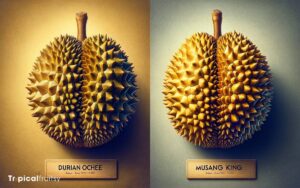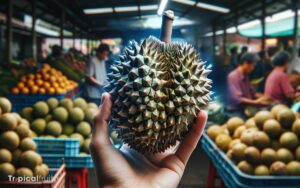How Much Is Durian in the Philippines? Prices Revealed!
The cost of durian in the Philippines typically ranges from PHP 150 to PHP 300 per kilogram.
However, prices can fluctuate based on the season, region, variety, market conditions, and where it is purchased, whether as a whole fruit or pre-packaged segments.
Durian prices in the Philippines are influenced by the following factors:
For instance, a Puyat variety durian might be more affordable during peak season in Davao compared to a specialty shop in Manila.
Durian aficionados can expect price variations across the Philippines, reflecting the dynamic market of this exotic fruit.
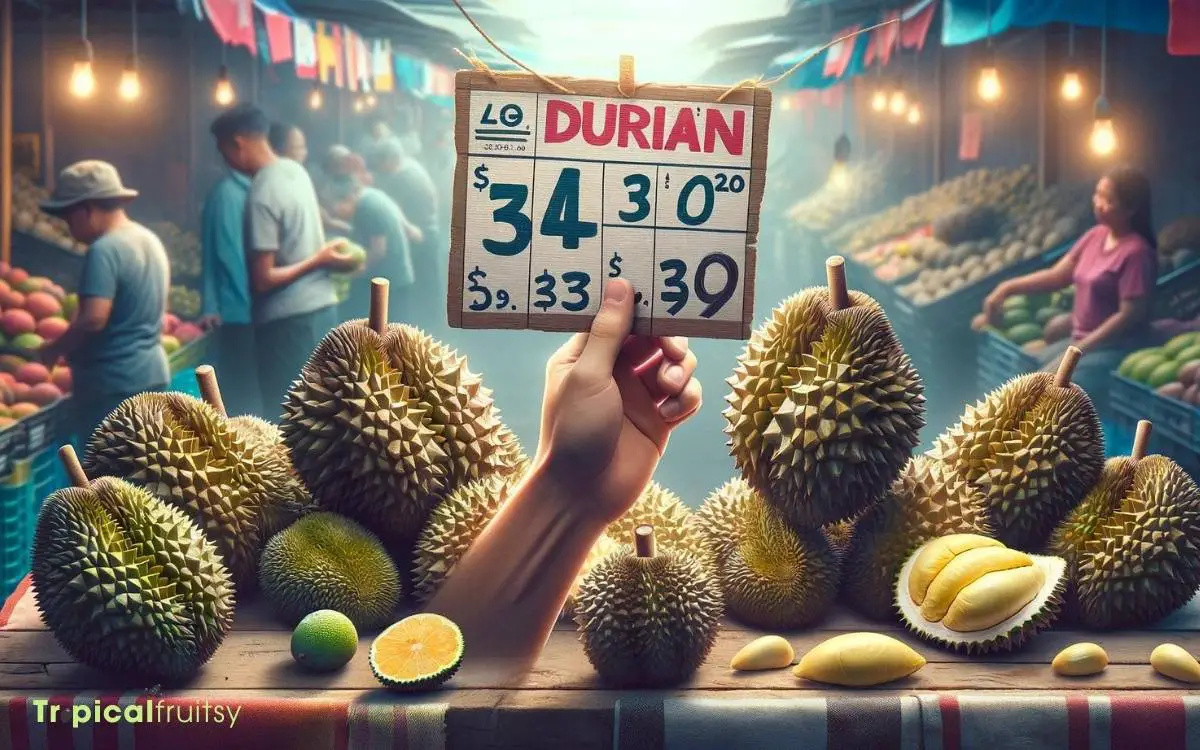
Key Takeaway
Durian Price Guide in the Philippines
| Season | Location | Variety | Price Range (PHP/kg) | Purchase Location |
|---|---|---|---|---|
| Peak (Aug-Oct) | Davao | Puyat | 150-200 | Street Vendor |
| Peak (Aug-Oct) | Manila | Puyat | 200-250 | Supermarket |
| Off-Peak | Davao | Alcon Fancy | 200-250 | Market |
| Off-Peak | Manila | Arancillo | 250-300 | Specialty Shop |
Understanding Durian Seasonality
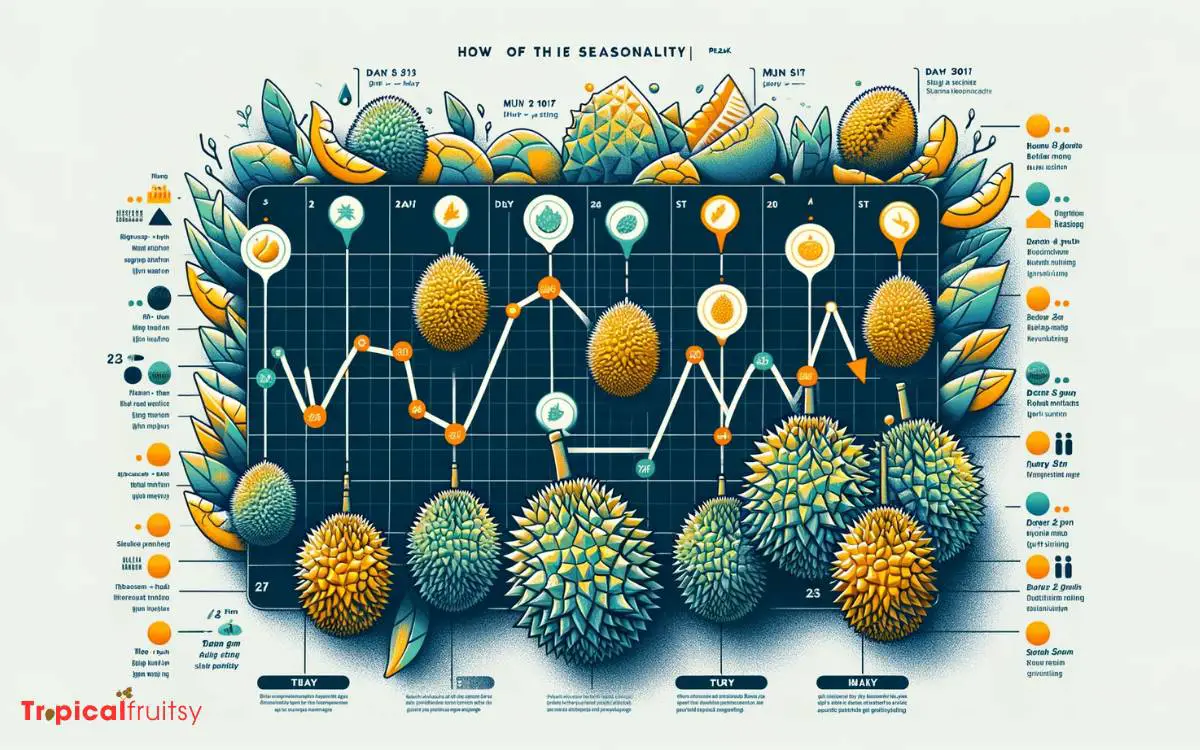
Typically, durian season in the Philippines peaks from August to October, which significantly influences the fruit’s availability and price.
During this period, the market experiences an influx of durians, which typically leads to more competitive pricing due to the increased supply.
Historical data shows that prices can fluctuate considerably throughout the season, impacted by factors such as weather conditions affecting yield, regional production variations, and consumer demand.
Precipitation levels and temperature can also affect the quality and volume of durian harvests, further influencing market availability.
Detailed analysis of these patterns is essential for both consumers and suppliers to predict pricing trends and to strategize purchasing or selling.
Understanding these dynamics sets the stage for examining regional price variations, which reflect the complexities of local durian markets.
Regional Price Variations
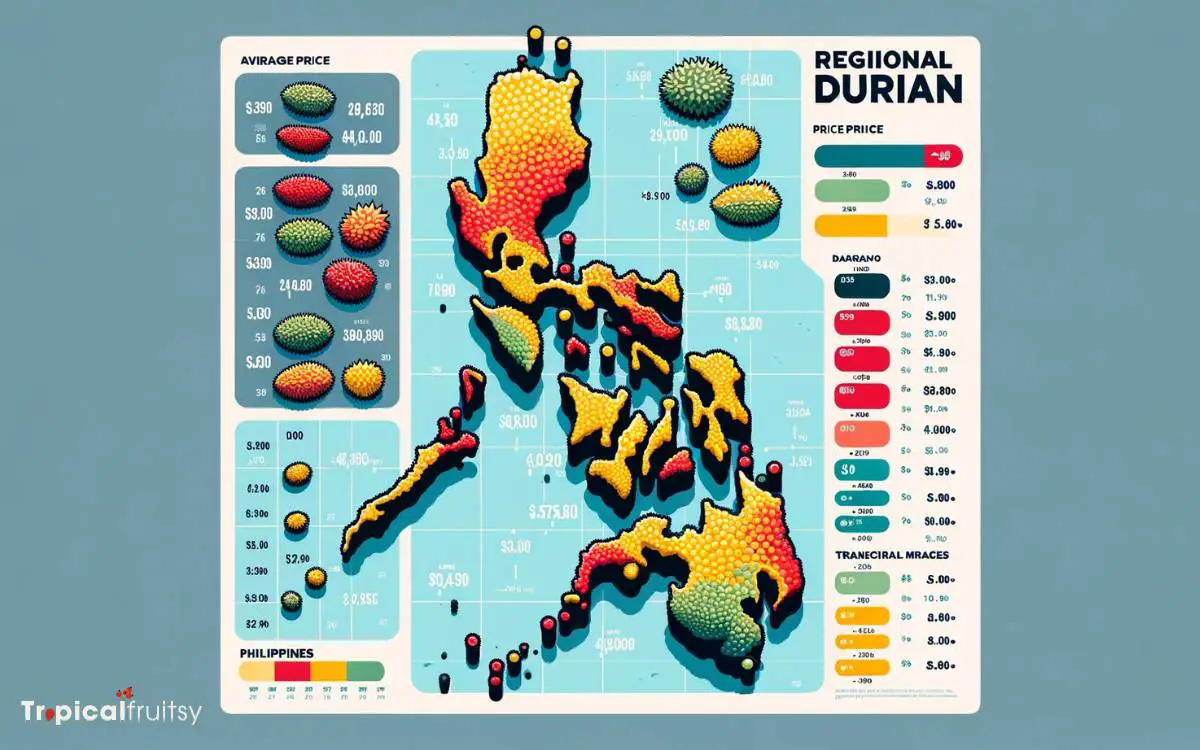
The cost of durian in the Philippines is influenced significantly by regional price variations, which stem from factors such as transportation, local demand, and accessibility to durian farms.
Analysis of market data indicates that prices can fluctuate based on geographic location, with urban centers often commanding higher prices due to increased overhead costs and consumer purchasing power.
Furthermore, these regional disparities are exacerbated during off-peak seasons, when limited supply from local harvests results in heightened price volatility.
Geographic Cost Differences
Durian prices in the Philippines vary significantly across different regions, reflecting disparities in local availability, demand, and transportation costs.
To illustrate these geographic cost differences:
- Mindanao: As a major durian-producing area, prices here are generally lower due to direct access to farms and lower transportation costs.
- Metro Manila: Prices spike due to the added costs of transportation from farm regions and the higher operational expenses of retailers in urban centers.
- Visayas: Prices can be variable; islands closer to durian-producing areas may enjoy lower prices, while more remote areas incur higher costs due to logistics.
A meticulous analysis of these regional price variations reveals that transportation exerts a substantial influence, as does the proximity to production sites.
This intricate pricing landscape sets the stage for understanding how seasonal price fluctuations further affect durian costs.
Seasonal Price Fluctuations
Seasonal trends significantly impact durian prices across the Philippines, with variations that mirror the complexity of regional production and distribution networks.
During peak harvesting times, prices generally decrease due to higher supply, while the off-season sees prices rising as availability dwindles.
Climate conditions, regional festivals, and export demands further influence these price oscillations.
| Region | Peak Season Price (PHP/kg) | Off-Season Price (PHP/kg) |
|---|---|---|
| Davao | 60-80 | 150-200 |
| Luzon | 100-120 | 200-250 |
| Visayas | 80-100 | 180-230 |
| Mindanao | 50-70 | 140-180 |
| Palawan | 110-130 | 210-260 |
It’s evident that geographical and seasonal factors coalesce to form a dynamic pricing landscape within the durian industry.
Durian Varieties and Costs

The cost of durian in the Philippines varies significantly across different varieties, with some types commanding premium prices due to their taste, texture, and rarity.
Analysis of market data indicates a price range that fluctuates between PHP 150 to PHP 500 per kilogram, depending on the variety such as Puyat, Arancillo, or Davao’s sought-after Presidente.
Furthermore, regional disparities in durian costs are observable, influenced by factors such as local production volumes, transportation logistics, and consumer demand.
Popular Durian Types
Several durian varieties are cultivated in the Philippines, each with its unique flavor profile and corresponding price point.
The country’s diverse agro-climatic conditions allow for the cultivation of numerous durian types, which are favored for their distinct tastes and textures.
To provide a clearer understanding of the market, here are three prominent durian varieties along with their typical costs:
- Puyat – Renowned for its rich and creamy taste, Puyat durians are sought after by enthusiasts and can range from PHP 150 to PHP 250 per kilogram.
- Arancillo – This variety is appreciated for its sweet and slightly bitter flavor, with market prices hovering around PHP 130 to PHP 180 per kilogram.
- Kob – Kob durians are known for their less overpowering smell and custardy pulp, typically sold at PHP 120 to PHP 160 per kilogram.
These prices are indicative and may fluctuate based on factors like seasonality and regional availability.
Price Range
Durian prices in the Philippines vary widely, ranging from PHP 120 to PHP 250 per kilogram depending on the variety and the time of year.
This price fluctuation is influenced by several factors, including the scarcity of certain varieties, the cost of cultivation, and the transportation expenses associated with bringing the fruit from farms to urban markets.
Premium varieties like Puyat and Arancillo typically fetch higher prices due to their superior taste, texture, and perceived rarity.
Conversely, more common types such as the native Durian and the Chanee variety may be priced lower.
Market dynamics also play a role; during peak season when supply is abundant, prices may dip, while off-season scarcity can drive costs upward.
Buyers should note that wholesale purchases and location-specific demand can further affect the pricing landscape.
Regional Cost Differences
We must consider regional cost differences when evaluating durian prices in the Philippines, as these can vary significantly between locales and are impacted by the availability of specific varieties.
An analytical assessment of the market reveals several factors contributing to these variations:
- Geographical Proximity to Farms: Areas closer to durian farms, such as Davao City, generally offer lower prices due to reduced transportation and logistics costs.
- Local Demand and Supply Dynamics: Regions with higher demand relative to supply, often urban centers like Metro Manila, may exhibit increased prices.
- Variety Availability: Some varieties, like Puyat and Arancillo, are rarer and thus command premium prices, particularly in regions where they are less cultivated.
To accurately gauge costs, one must analyze regional production volumes, logistical networks, and consumer preferences, which collectively shape the pricing landscape for durian in the Philippines.
The Impact of Harvest Conditions

While the price of durian in the Philippines is subject to variation, harvest conditions such as climate patterns and seasonal changes play a crucial role in determining its cost.
Fluctuating weather conditions, including variations in rainfall and temperature, directly affect durian tree health and fruit development, potentially impacting yield volumes.
Extended periods of drought or excessive rainfall can lead to crop failures or reduced quality, thereby elevating prices due to scarcity.
Moreover, the timing of the durian season, which typically peaks between August and October, may shift as a result of climate anomalies, causing supply disruptions.
Detailed analysis of weather data and harvest reports is essential in forecasting production levels and anticipating market fluctuations, enabling stakeholders to make informed decisions regarding pricing strategies.
Market and Street Vendor Pricing

Given that harvest conditions significantly influence supply, the pricing of durian at markets and street vendors in the Philippines can vary considerably, reflecting the interplay between availability and consumer demand.
To provide a detailed and analytical perspective on durian pricing, consider the following factors:
- Seasonality: Durian prices tend to decrease during peak harvest season due to a higher supply. Conversely, prices can escalate during off-season periods when the fruit becomes scarce.
- Quality Grades: Premium durians, characterized by their taste and size, command higher prices than lower-grade varieties, impacting the overall market pricing structure.
- Regional Variations: Costs may differ based on the region, with areas closer to durian farms typically offering more competitive prices due to lower transportation and logistics expenses.
These elements collectively contribute to the dynamic pricing landscape for durians in the Philippines.
Supermarket Vs Specialty Shop Rates
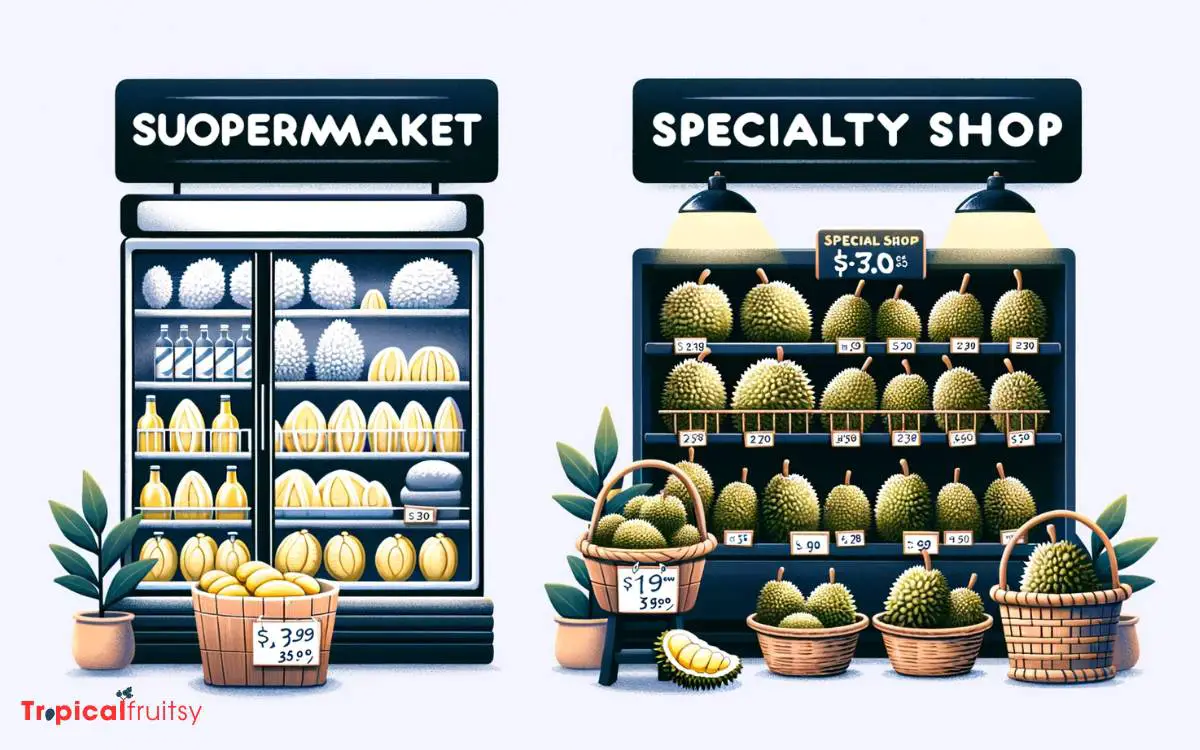
Although durian prices at local markets and street vendors fluctuate with seasonality and quality, supermarkets and specialty shops often maintain more stable rates, reflecting their consistent supply chains and pricing strategies.
Consumers looking to purchase durian through these outlets can anticipate less variation in pricing, but should be mindful of the premium that may be attached for the convenience and quality assurance these establishments offer.
Here is an analytical comparison of supermarket and specialty shop durian rates:
| Outlet Type | Average Price per Kilo (PHP) |
|---|---|
| Supermarket | 350 |
| Specialty Shop | 375 |
| Supermarket (Off-Season) | 400 |
| Specialty Shop (Off-Season) | 425 |
| Supermarket (Peak Season) | 300 |
| Specialty Shop (Peak Season) | 320 |
The Role of Import and Export

Considering the Philippines’ position as both a consumer and producer of durian, the dynamics of import and export have a significant impact on domestic pricing and availability.
The interplay of international trade can be elaborated through the following points:
- Export Volume: An increase in exports can tighten domestic supply, potentially elevating prices if demand remains stable or grows.
- Import Regulations: Strict phytosanitary laws governing the import of durian can affect the volume and frequency of incoming shipments, influencing market saturation and price points.
- Global Market Trends: The Philippines’ durian prices are influenced by global demand patterns, especially from major consuming countries like China, which can absorb significant quantities and thus affect the local market.
Buying Whole Vs Pre-Packaged Durian
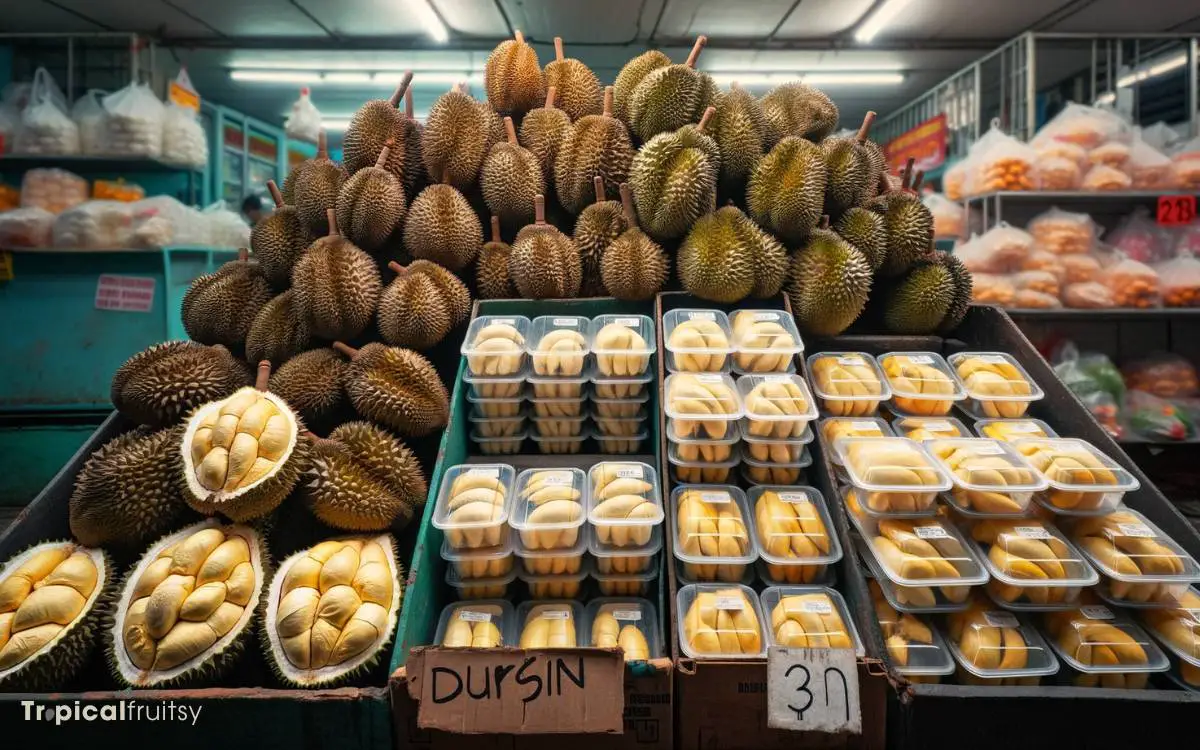
Addressing the choice between whole and pre-packaged durian, consumers in the Philippines must weigh factors such as cost, convenience, and freshness when making their purchase.
The decision is not merely a matter of personal preference but also a reflection of market trends and availability.
An analytical approach to this comparison necessitates a detailed examination of the pros and cons associated with each option.
| Factor | Whole Durian | Pre-Packaged Durian |
|---|---|---|
| Cost | Variable | Typically Higher |
| Convenience | Low | High |
| Freshness | High | Moderate |
| Shelf Life | Short | Extended |
| Selection | Broad | Limited |
Pre-packaged options, while more expensive, provide extended shelf life and ease of consumption, albeit with a possible compromise on freshness and variety.
Tips for Bargaining and Purchasing
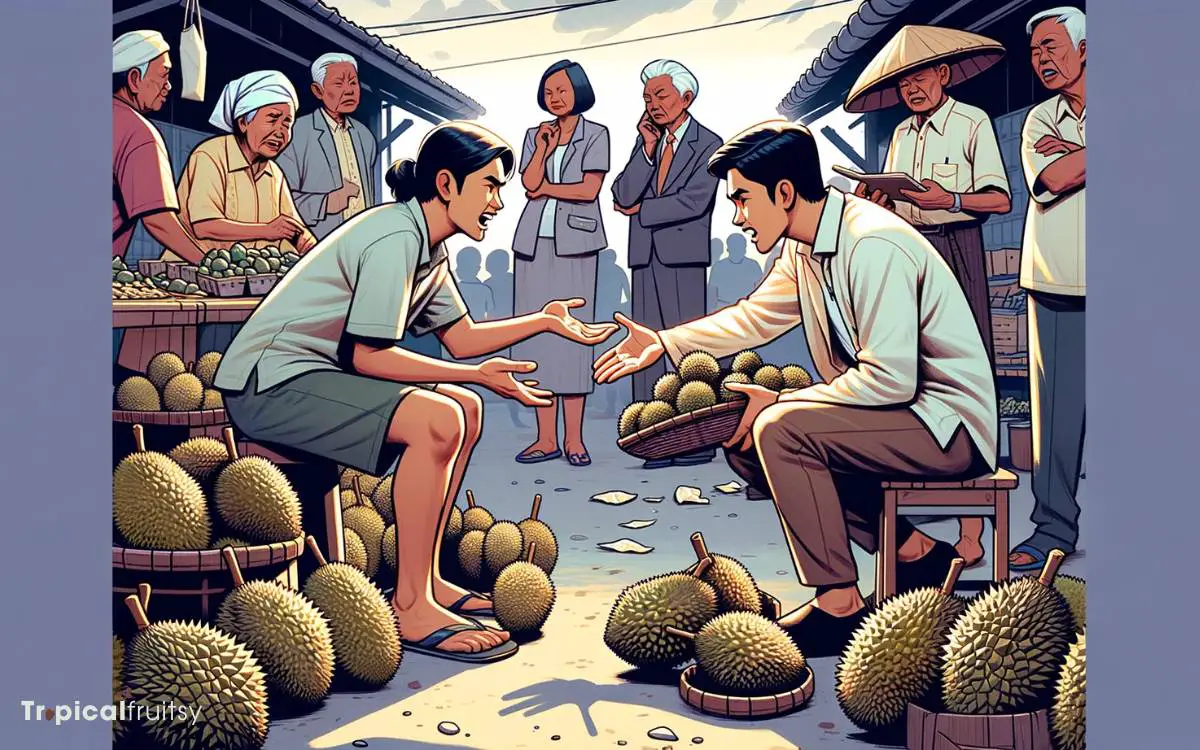
To effectively negotiate the price of durian in the Philippines, buyers should arm themselves with knowledge about the current market rates and seasonal availability.
Understanding these factors allows for an informed approach to bargaining that can result in substantial savings.
When preparing to purchase durian, consider the following strategies:
- Research Average Costs: Prior to engaging with sellers, analyze current pricing trends for durian across various regions and marketplaces to establish a baseline for negotiation.
- Assess Durian Quality: Examine the fruit for freshness and ripeness, which directly impact value. Use this assessment as leverage in price discussions.
- Time Your Purchase: Leverage supply fluctuations; prices may be more negotiable during periods of high availability or at the end of the day when sellers are keen to close sales.
Conclusion
The cost of durian in the Philippines fluctuates like the tides, influenced by a complex interplay of seasonality, regional disparities, and variety-specific factors.
Market forces, dictated by harvest conditions and the intricacies of import-export dynamics, further complicate pricing structures.
Discerning consumers must navigate a labyrinth of options between marketplaces and retail formats, balancing the allure of cost savings against quality considerations. Strategic bargaining remains a quintessential skill for those seeking the best value.


